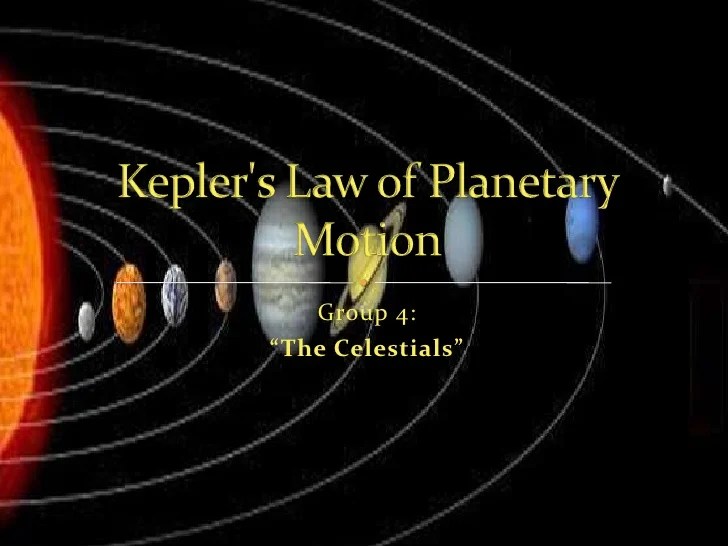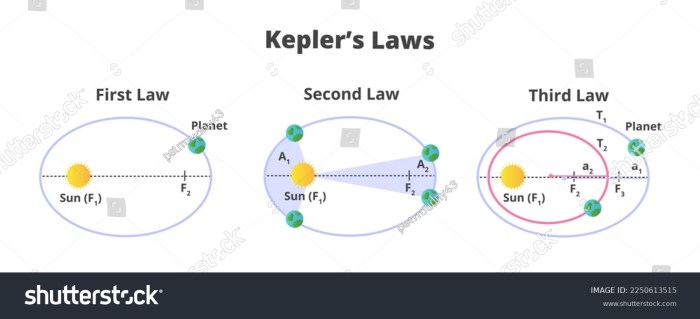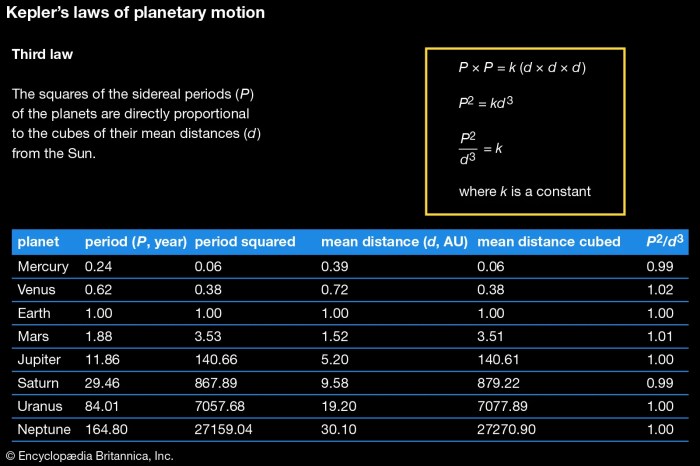Kepler’s 3 Laws of Planetary Motion Worksheet Answers provide a comprehensive guide to understanding the fundamental principles governing the movement of celestial bodies. This insightful resource unravels the complexities of planetary motion, empowering learners with the knowledge to decipher the intricate dance of our solar system.
Through a series of engaging explanations, mathematical representations, and practical applications, these worksheet answers illuminate the significance of Kepler’s laws, their historical context, and their profound impact on astronomy and space exploration.
Kepler’s Laws of Planetary Motion: Kepler’s 3 Laws Of Planetary Motion Worksheet Answers

Kepler’s laws of planetary motion are three laws describing the motion of planets around the Sun. They were formulated by Johannes Kepler based on the observational data collected by Tycho Brahe. Kepler’s laws laid the foundation for Isaac Newton’s law of universal gravitation and are still used today to calculate the orbits of planets and other celestial bodies.
The First Law of Planetary Motion, Kepler’s 3 laws of planetary motion worksheet answers
The first law of planetary motion states that the orbit of a planet around the Sun is an ellipse, with the Sun at one focus. This means that the planet’s distance from the Sun varies throughout its orbit, being closest at perihelion and farthest at aphelion.
- Examples of the first law in action include the elliptical orbits of Earth, Mars, and Jupiter around the Sun.
- The first law is significant because it provides a mathematical description of the shape of planetary orbits, which is essential for understanding their motion.
The Second Law of Planetary Motion
The second law of planetary motion states that a line connecting a planet to the Sun sweeps out equal areas in equal times. This means that the planet’s speed varies throughout its orbit, being fastest at perihelion and slowest at aphelion.
A mathematical representation of the second law is:
dA/dt = constant
where dA is the area swept out by the line connecting the planet to the Sun, and dt is the time interval.
The second law is related to the conservation of angular momentum. As the planet moves closer to the Sun, its speed increases, but its angular momentum remains constant. This is because the Sun’s gravitational force exerts a torque on the planet, causing it to speed up.
The Third Law of Planetary Motion
The third law of planetary motion states that the square of the orbital period of a planet is proportional to the cube of its average distance from the Sun. This means that planets that are farther from the Sun take longer to orbit it.
A mathematical representation of the third law is:
T^2 = k – r^3
where T is the orbital period, r is the average distance from the Sun, and k is a constant.
The third law has implications for understanding the solar system. It explains why Mercury, which is closest to the Sun, has the shortest orbital period, while Pluto, which is farthest from the Sun, has the longest orbital period.
Applications of Kepler’s Laws
Kepler’s laws are used to calculate orbital parameters, such as the eccentricity, semi-major axis, and period of an orbit. They are also used to predict planetary positions, which is essential for navigation and space exploration.
Historical Context
Kepler discovered his laws of planetary motion in the early 17th century. He based his work on the observational data collected by Tycho Brahe. Kepler’s laws were a major breakthrough in astronomy and laid the foundation for Isaac Newton’s law of universal gravitation.
Kepler’s laws contributed to the scientific revolution by providing a mathematical description of planetary motion. This helped to dispel the prevailing belief that the universe was governed by supernatural forces and paved the way for the development of modern science.
Worksheet Answers
[Jawaban pertanyaan lembar kerja tentang hukum gerak planet Kepler.]
Clarifying Questions
What is the significance of Kepler’s first law?
Kepler’s first law establishes that planets orbit the sun in elliptical paths, with the sun located at one of the foci of the ellipse. This law provides the foundation for understanding the non-circular nature of planetary orbits.
How does Kepler’s second law relate to conservation of angular momentum?
Kepler’s second law states that a line connecting a planet to the sun sweeps out equal areas in equal time intervals. This law is a manifestation of the conservation of angular momentum, indicating that the planet’s angular momentum remains constant as it orbits the sun.
What are the implications of Kepler’s third law for understanding the solar system?
Kepler’s third law reveals a mathematical relationship between the orbital period of a planet and its average distance from the sun. This law allows astronomers to determine the orbital periods of planets based on their distances from the sun, providing insights into the structure and dynamics of our solar system.


